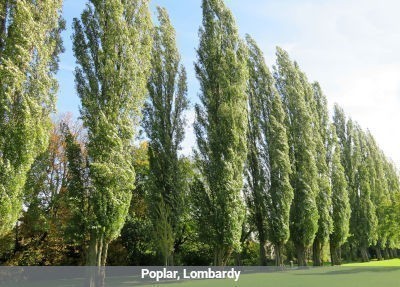Windbreaks
An effective windbreak can be most useful in reducing wind damage. The aim is to make a screen which filters the wind, rather than a solid barrier which often causes 'eddying'. Research has shown that a windbreak will protect an area downwind of approximately ten times the height of the windbreak.
PLANTS FOR WINDBREAKS For tall windbreaks, we recommend planting three rows of trees with 90cm (3ft) between rows and 150cm (5ft) between trees. In later years, the windbreak may be thinned. For windbreaks of 5m (15ft) or more in height, we suggest the following Poplars: Lombardy or White.
For tall windbreaks, we recommend planting three rows of trees with 90cm (3ft) between rows and 150cm (5ft) between trees. In later years, the windbreak may be thinned. For windbreaks of 5m (15ft) or more in height, we suggest the following Poplars: Lombardy or White.
If you wish to include an evergreen in the windbreak, Leyland Cypress or Thuja Plicata Atrovirens planted 10ft (3m) apart with 3 Grey Alder in between is often recommended. If an evergreen windbreak is required, use Leyland Cypress or Thuja Plicata Atrovirens planted at 2 - 3m (7 - 10ft) intervals in two rows 1.8 - 2.4m (6 - 8ft) apart, or a single row 1.8m (6ft) apart.
For small windbreaks, Grey Alder is reliable planted 60 - 90cm (2-3ft) apart in a single row, although many other hedging plants can be equally effective. Click here for a selection of taller hedging plants that can be planted in windy sites.
WINDBREAK PRODUCTS
Windbreak Netting - (50% wind protection), currently unavailable.
Tree/Shrub shelters - (offer protection against wind, frost, and browsing animals!)

